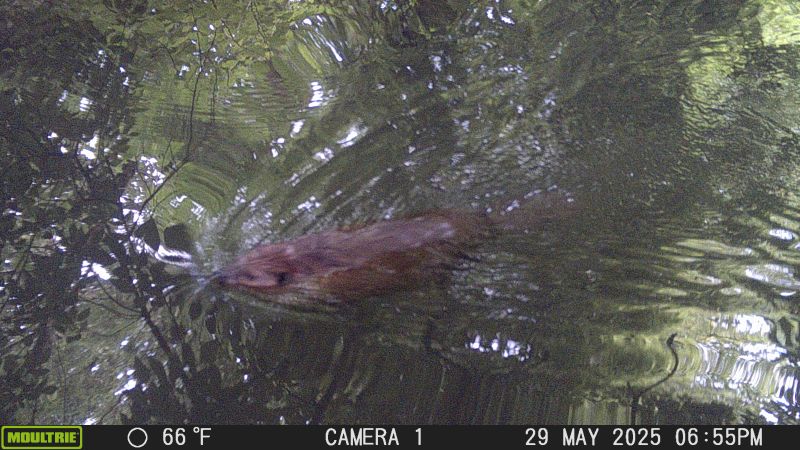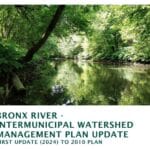By RJ Hawkins
In late May 2025, something surprising was spotted in the Bronx River that hasn’t been seen for a very long time: a beaver! Beavers have not been seen in the Bronx River since José the Beaver in 2018. José was first spotted in the river in 2007 and was the first beaver seen in New York City in over 200 years. While José and a second beaver, Justin Beaver, lived together for a number of years on the river they are believed to have passed away, leaving a keystone species missing from the ecosystem.
From June to October 2024, data collection occurred at the Mitsubishi Walk section of the Bronx Zoo to try to see if there were any beavers currently living in the Bronx River. Two camera traps each were placed upstream and downstream of the Twin Dams at Mitsubishi Riverwalk. The animals observed were:
Muskrats
Common snapping turtles
Painted turtles
Red-eared sliders
unidentified Deirochelyinae turtle species
Bluegill sunfish
Common carps
Gray catbirds
Red-winged blackbirds
European starlings
Mourning doves
Wood ducks
Common raccoons
Coyotes
Great egrets
Great blue herons
Mallard ducks
Canada geese
While no beavers were spotted during the data collection, the data did present insight into how impactful dams can be in urban ecosystems. Normally, beaver dams increase biodiversity in an ecosystem by creating pond/wetland habitats that weren’t there previously. This creates a diversity of habitat types that provides a space for specific animal and plant species to thrive. During this monitoring period, many more species of animals were observed upstream of the dam than were observed downstream of the dam. This suggests that although there are many issues with urban dams (such as migratory fish and eel species not being able to travel upstream) they may be able to support biodiversity by creating the pond/wetland ecosystems. In places so heavily urbanized such as New York City this is an important discovery as it shows that these habitats need to be maintained as biodiversity hotspots.
In April to May of 2025 camera traps were set up at Mitsubishi Riverwalk again in the hopes of catching a glimpse of any beavers. At the end of May the animals spotted over the two month period on the camera traps were:
Muskrats
unidentified Deirochelyinae turtle species
Red-winged blackbirds
Spotted sandpipers
Common grackles
European starlings
Yellow-rumped warbler
Mourning doves
Blue jays
American robins
Green herons
Double-crested cormorant
Wood ducks
Common raccoons
Coyotes
Great egrets
Great blue herons
Mallard ducks
Canada geese
Beaver
Incredibly enough, this time a beaver was seen on the footage swimming past the camera trap. This was such an amazing discovery because not only does it show how much biodiversity this section of the river can support, but it also signals the return of a species that had been absent, suggesting significant ecological recovery in an urban environment. Similarly to the monitoring from 2024, there were more species observed upstream of the dam than downstream of the dam.
The results from these monitoring studies provide insight into next steps of dam removal and species reintroduction along the Bronx River. Currently dam removal on rivers is gaining popularity as dams are removed to help restore rivers back to their natural state before colonization/industrialization. Removing dams is beneficial because it helps to restore natural river flows, improve water quality, and reconnect fragmented habitats, allowing for the return of fish and wildlife. Free-flowing rivers also enhance sediment transport, which is crucial for maintaining riverbed health and downstream ecosystems.
Currently, dam removal is being examined on the Bronx River. While this would provide benefits to the ecosystem, removing the dams might also remove the pond/wetland habitat they created, possibly lowering species diversity in those areas of the Bronx River ecosystem. In their absence, Beaver Dam Analogs (BDAs) can be implemented. BDAs are artificial beaver dams that provide the same benefits that beaver dams do. Beavers are also more likely to stay in areas of a river that have BDAs and will colonize the dams as their own. If dam removal goes through, implementing BDAs could be a win-win situation as they would help keep the beaver habitat and biodiversity benefits of the man-made dams while restoring the river to a more natural state and allowing for migratory fish and eel species to pass. Let’s hope that this is just the beginning of beaver sightings in the Bronx River in 2025.
(The research is under review in preparation for publication, and has not yet been peer-reviewed).





